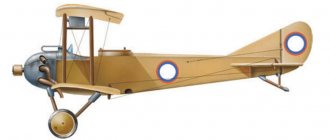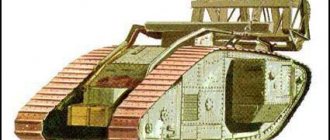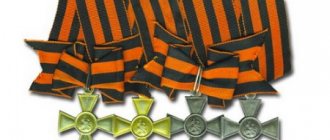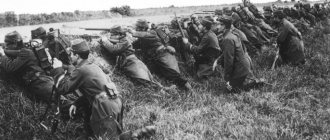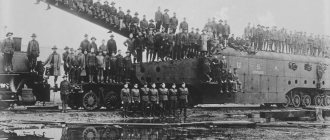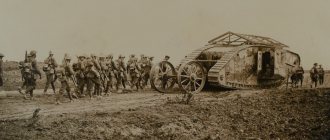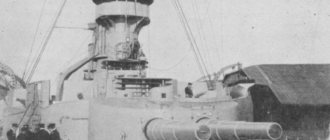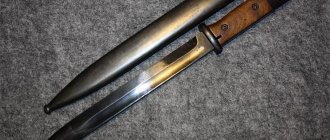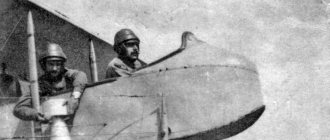Industrial and scientific technologies of the First World War concerned mainly military equipment, but this race of inventions really changed the world, which, after the PMR and the subsequent revolutions, finally lost its innocence, nobility and naivety. The categorical positive consequences of the four-year massacre are the development of medicine and pharmacology, which, thanks to the meat grinder, made a giant leap forward on numerous battlefields - the invention of such medical instruments and devices as the Colt stretcher for narrow trenches, a portable fluoroscope, an electromagnet for surgeons, a Hirtz compass, a Scott oxygen mask , hand prostheses, the Boyle apparatus, as well as the emergence of the concept of “post-traumatic stress disorder,” which a hundred years ago was called “shell shock.” The remaining major metamorphoses relate to weapons, which all key participants in the hostilities developed quantitatively and qualitatively.
Tanks
The infamous Battle of the Somme is famous, among other things, for the first use of tanks. The achievement belongs to the British army and, accordingly, the name of the new weapon turned out to be in English - “tank”. The first tank attack took place in the fall of 1916, although the first attempt was ineffective. Bulky heavy vehicles bogged down, got stuck in soft ground, broke down and failed for other technical reasons, but even a negative result did not prevent the warring parties from realizing that tanks are the future and after improving the tracked drive and fuel system, armored combat vehicles will turn into the most terrible instrument of war .
Allied forces advancing with tanks on Bapaume, France. 1917 (Photo: National Library of Scotland)
German tank A7V, of which less than 100 were produced. (Photo: National Archives / Official German Photograph)
Tanks abandoned in the mud on the battlefields near Clapham Junction, Ypres, Belgium, 1918 (Photo: James Francis Hurley / State Library of New South Wales)
French Renault FT-17 tanks are heading towards the front line in the Argonne Forest. France, 1918. (Photo: NARA)
British Mark I tank. (Photo: National Library of Scotland)
Holt's gas-electric tank is the first American tank. The project never made it past the prototype stage, proving to be too heavy and ineffective in design. (Photo: AP)
New Zealand troops and a tank stuck in a trench. France, 1918. (Photo: Henry Armytage Sanders/National Library of New Zealand)
A British-made Mark IV tank captured and repainted by the Germans. (Photo: Nicolas Joseph Gustave Crouvezier / Archives municipales de Nancy) Interesting articles
- The most fashionable dances of the 1960s
- Fashionable clothes of the 80s in the USA (men's and women's)
- History of the NBA logo
- Who are the Beats - history and photographs of the Beat Generation
Aviation
Since ancient times, people have dreamed of taking to the skies, experimenting with flying machines for centuries.
On December 17, 1901, aviation pioneers brothers Orville and Wilbur Wright took off for twelve seconds and carried out the first flight in history. And three or four years later, the Wrights and other aviators were already covering tens of kilometers. Each time the pioneers risked their lives, but turned their inventions into a fairly reliable and efficient form of transport, which in 1914-18 was logically used for the needs of the front. The rapid development of First World War technologies can be seen especially clearly in the example of aviation, which in a matter of months experienced impressive changes, quickly going from reconnaissance to a fearsome combat unit. At first, army leaders saw the aviators exclusively as reconnaissance officers, but the pilots quickly learned to perform other tasks - shelling trenches with machine guns, dropping bombs on enemy trenches and buildings, and also staging exciting duels in the air. At the initial stage of the war, pilots had only personal weapons, and their assistants manually dropped artillery shells equipped with a special stabilizer on the tail. In 1917-18, engineers were able to synchronize machine gun fire with the propeller's stroke in order to safely shoot through it, and the artillery arsenal was enriched with incendiary, fragmentation and high-explosive bombs. From the hundred or two aircraft that the warring countries had at the initial stage, the aircraft fleet increased hundreds of times. Historians give an approximate figure - 11 thousand bombers, reconnaissance aircraft and fighters. Opponents often attacked key enemy cities with entire armadas of aircraft, making day and night flights. For example, the Germans were especially fond of night raids on Paris, which forced the French to come up with an elegant and inventive way to protect the capital from German bombing in "Fake Paris".
In parallel, naval aviation developed, for which pilots learned to land and take off from the deck of aircraft carriers, although the time for this military branch would come much later.
French two-seat reconnaissance aircraft SPAD S.XVI. (Photo: San Diego Air and Space Museum Archive)
British Handley-Page bombers during a mission on the Western Front. (Photo: Tom Aitken/National Library of Scotland)
British fighter Bristol F.2. (Photo: Frank Hurley/State Library of New South Wales)
French Farman plane with missiles. (Photo: National World War I Museum, Kansas City, Missouri, USA)
German single-seat fighter aircraft Pfalz Dr.I. (Photo: San Diego Air and Space Museum Archive) Hot air balloons near Koblenz, Germany. (Photo: Keystone View Company)
British reconnaissance aircraft over the front line in France. (Photo: National Library of Scotland) Captain Maurice Hupp (back seat) - commander of the French MF 29 squadron on the Farman MF.11 bomber. (Photo: Library of Congress)
German seaplane (Photo: US National Archives)
A Sopwith 1 1/2 Strutter biplane taking off from a ship. (Photo: State Library of New South Wales)
Australian Flying Corps unit in Palestine, 1918. (Photo: James Francis Hurley/State Library of New South Wales)
The legend of the “walking tank”. Mysteries of the First World War
This message looked like a complete canard. So much so that it didn’t even seem worthy of recording the exact link back then. Well, in fact: such a machine is impossible today! Most likely, there are repetitions of rumors (if not deliberate misinformation: it’s wartime!), spread either in “anticipation” of the first tanks entering the battlefield, or after that - but before their strengths were truly realized and weaknesses, optimal type of design, etc.
Rice. 1 "Robot" Jordaan
But already today, in Germany, when working with European literature from the era of the First World War, one of the co-authors (the same one) managed to find similar references. No, not technical descriptions, but brief mentions in newspapers and magazines, drawings - sometimes caricatured, but sometimes not quite... I was impressed by a drawing by the Dutch artist L. J. Jordaan, published without comment in one of the issues of the weekly De Groene "for 1917 (Fig. 1).
Yes, of course, Jordaan and his other contemporaries most likely depicted the allegorical “horrors of war”: general dehumanization, replacement of man with military equipment... And yet the question arises: was one of the military designers developing a project for such a walking “tank”? robot"? Exactly the project: its technical implementation is unrealistic - but rumors about developments could penetrate into the wartime press, which was greedy for sensations.
All this prompted a repeated search in Russian journals relating to the last pre-revolutionary months. In the end, we managed to find a very similar note: it seems, not the same one that caught our eye a quarter of a century ago - but clearly describing the same “invention” (?):
According to Electricity and Life, the American engineer Pieper invented a new military machine - a mechanical human figure that “walks” with the help of two 40 hp electric motors. in the body and one in 2 hp. in my head. The last motor controls the movements. The figure is 3 meters high and weighs 150 kg. fits 4 people freely in the armored chest. The “Grey King” (the name was given by the inventor) is a modification of the counter-destroyer - a fighter, but, of course, in battles on land.
(“Nature and People”, No. 41-42. 1917).
It is clear that this project was unlikely to even be accepted for implementation. Nevertheless, even after the First World War, mass consciousness in all countries was regularly “fed” by new rumors about such developments. Suffice it to recall what was written already in the 30s. “Poem about a Robot” by S. Kirsanov (a terrible poet, a cheap knockoff of Mayakovsky), where the military equipment of the coming war looks exactly like this: walking armored giants equipped with machine guns, and in addition also radio-controlled...
These rumors finally died out in an era much closer to the Second World War than to the First. However, it is all the more interesting to trace when they were born. Oddly enough, it seems that the real roots of this story actually go back to the era of the first machines, which are the direct ancestors of tanks. First of all, we are talking about the Burrell-Boydell machine. More precisely, about the trackless steam locomotive of Charles Burrell, equipped with wheels (?) of James Boydell.
Boydell called his design, developed and tested in the 1850s, the “endless walking rim.” These were, of course, still wheels - but equipped with spring-loaded “feet”, which retained quite significant mobility relative to the mounting axis (for which, when developing the design, the structure of the human ankle joint was taken into account). It was the human foot that was taken as the basis, with a protruding big toe on the inner edge of the “sole” and a “row of toes” gradually decreasing towards the outer edge. True, the English designer did not follow the path of mechanical copying: there were not five, but three finger “ledges” - and the same number of them were symmetrically located on the rear edge of the sole. The number and size of these feet had to be carefully calculated in relation to typical wheel sizes. They were made from durable wood and reinforced with steel. When driving (walking?), these blades partially overlapped, “stepping” on each other - and thereby providing the wheel with reliable support.
Boydell did not think at all about the military use of his invention, nor about putting it on steam locomotives. This was a development intended for freight carts moving off-road or on poor roads (a very pressing issue for Great Britain with its colonial possessions). However, in 1855, its “walking wheels” were successfully tested on Burrell’s steam locomotive: a relatively small machine weighing 9 tons, originally conceived as a “multi-purpose” tractor - including a military one, because. the tests actually took place during the Crimean War that had already broken out (Fig. 2).
Rice. 2 “Burrell-Boydell” according to the drawing of 1857. This logomotive had only forward gear, control (from almost a ship’s wheel) was also transferred only to the front wheels
The completion of the work coincided with the moment when the British command had serious problems supplying its troops.
Ammunition and food were delivered to the allied corps via a narrow-gauge railway, specially laid between Balaklava and Sevastopol, but it was too difficult to serve the 170,000-strong army using it alone.
And problems too often arose with horse-drawn transport on Crimean roads...
At first, the War Department was going to order a large batch of wheels with Boydell “paws” for wagons. However, it turned out that, in addition to them, there were already two fully debugged trackless steam locomotives. The famous design engineer James Cowan immediately proposed that these locomotives be armored with steel sheets and used for the offensive. The armor was supposed to protect from enemy bullets not only the driver and fireman, but also several shooters firing through special loopholes. It was assumed that these would be ordinary soldiers with hand-held infantry weapons (long-range rifles).
In the “anti-bullet” version, this idea was quite feasible, especially considering the weak penetrating power of the guns then in service with the Russian army. Perhaps even the armor that protects from the spent fragments of gun bombs would not be too heavy either. However, suddenly Cowan made an additional proposal: to equip the wheel hubs with scythe blades, like the war chariots of antiquity. The War Department immediately indignantly rejected this as “a barbaric idea contrary to the norms of war in the 19th century.” - and immediately hesitated whether it was worth purchasing Burrell-Boydell at all.
While these hesitations lasted, the war managed to end. Nevertheless, with a two-year delay, both locomotives were purchased by the government - in 1857-1858. passed a series of additional tests. Without armor, shooters, and especially without combat scythes: only as tractors.
(To this day, in Russian scientific and especially popular scientific literature, there are references to steam tractors used by the British in 1854-1855 during the siege of Sevastopol. Yes, these are the same “Burrell-Boydells”. The logical chain here is as follows: the British government was gathering purchase these locomobiles to solve some problems that arose during the siege of Sevastopol 1854-1855 - the British government acquired these locomobiles for the siege of Sevastopol 1854-1855 - the English army used locomobiles for the siege of Sevastopol Despite the fact that in 1854 the wheels Boydell and Burrell’s steam engine existed separately, and a year later, although they “united”, they did not enter service at all; this legend took on an independent life - and went to travel through the pages of even quite authoritative publications...)
In off-road conditions, “walking wheels” performed quite well, especially if you did not demand too much from the steam engines of that time. Official information about the power of Burrell's locomobile has not been published anywhere, nor has it been published about its maximum speed on Boydell's wheels. But it is known that this car could drag behind it a small “train” of convoy carts connected together. Or a heavy weapon - and sixteen more soldiers sitting on its wheeled carriage. At the same time, the Burrell-Boydell successfully overcame both a fairly steep ascent and descent, developing no less speed than required from a convoy transport or an artillery tractor.
However, it turned out that wooden “feet” behaved much better on dirt off-road than on even a moderately rocky path: thanks to spring loading, they held a point load well if it was directed along the axis of the paw - but not across, so that when hitting a large stone the wooden blade could split. And since a significant part of the tests were carried out right next to the arsenal building, on cobblestone streets, the ministry came to the conclusion that the “wheel with legs” was futile for military purposes.
Nevertheless, Boydell’s development stimulated active design research in the field of “walking wheels.” Ultimately, he led to the invention of a workable caterpillar (ineffective versions of it existed even before Boydell), but at the same time several very interesting “transitional” designs arose. For example, Bram Diplock’s “walking wheel” (1899), on the basis of which he created a “walking caterpillar” in 1910 (Fig. 3 a, b).
Rice. 3 a) “Walking Wheel” by Diklok. Structural materials, besides steel - rubber and still wood b) The Diplock caterpillar, developed 11 years later, contains much fewer “walking” elements
American engineers also did not remain aloof from these ideas. They were mainly concerned with “classic” caterpillars, but starting in 1893, a much more outlandish project was widely discussed in the pages of American newspapers, perhaps becoming the immediate predecessor of the “Grey King”.
This project was called “Steam Man”. It was about a compact steel walker motor capable of developing half a horsepower. The engine ran on gasoline - but it was a steam engine, not an internal combustion engine. The latter had already appeared, but were still extremely undeveloped - in contrast to steam engines, which were just experiencing the pre-sunset period of highest perfection (Fig. 4).
Rice. 4 “Steam Man” (another popular name is “knight-smoker”)
For all modern walker designs, one of the most difficult problems to solve is stability. For The Steam Man this problem was not particularly acute. It was not a crew, but just an engine; it had to be harnessed into the “shafts” of the cart and controlled using a rigid analogue of the “reins” - in the spirit of a ship’s tiller (the first cars were driven by this principle: only at the beginning of the 20th century did the “cow tail” tiller give way to another ship design, the steering wheel). "steering wheel").
Was this “robot” embodied in hardware? The data on this matter is contradictory. Information about the “Steam Man” circulated in the press for a long time, then disappearing from newspaper pages, then reappearing a few years later. One report from 1900 speaks of it as a working machine that had just been built by the Canadian engineer Georges Moore (we won’t risk transcribing his name, since it is not clear whether it should sound English or French).
Even if this is true, such a walker could not have any practical significance: at best, it is capable of providing “stepping” speed. And the requirements for the chassis are extremely difficult to meet, the estimated power is 0.5 liters. With. (was it possible to achieve it?) is too small, the control is too imperfect, gasoline as a fuel is far from safe (it is now used in carburetor engines). And we’re not even talking about transforming the “Steam Man” into a battle tank.
But maybe engineer Pieper (who is he, by the way? His name is not listed in any of the authoritative studies on the history of vehicles and military equipment) invented a completely original design?
Let’s try, as they say, “on our fingers” to sketch out the layout diagram of the “Grey King”. Let's assume that the machine has at least approximately the same proportions as a person (which would be quite reasonable). This gives us the height of the combat compartment and the engine-transmission compartment combined with it, no more than 1.7 m. Even if we take the length and width of the hull equal to 1.5 m (this is no longer possible, otherwise the initially unstable vehicle will become catastrophically unstable), this will give us the reserved volume where - something under 4.5 cubic meters - if the body has the shape of a parallelepiped. The volume of a more durable and technologically advanced case in the form of a cylinder with a diameter of 1.5 m will be less than three and a half cubic meters, so we will not consider this option. The fighting compartment for two machine gunners cannot be made into less than three “cubes” even with the disregard for ergonomics at that time. (Electric motors seem to eliminate the problem of gasoline vapors and exhaust gases - but the pollution of the fighting compartment will be more than ensured by the batteries and, most importantly, by the working machine guns themselves!).
There is a maximum of one and a half “cubes” left for the engine with servicing systems. Even an inveterate optimist could not squeeze the then “engine” of the required power into such a volume. Even (especially!) if it is an electric motor, especially three electric motors: batteries of those times produced at most 15 Wh per 1 kg of their own weight, and needed frequent recharging. Consequently, they required much more volume than an internal combustion engine, approaching in these indicators more likely to a steam engine.
There is no room left at all for a transmission with very complex kinematics: it is impossible to place it in the “legs”.
So, the impossibility of creating a layout diagram immediately cancels out all subsequent stages. Thus, all that remains of the project is an idea, a very catchy one, it should be noted. So catchy that journalists simply could not pass by such a “treasure”...
Indirect confirmation of the “stillbirth” of the project: approximately the same quarter of a century ago, the collection “Walking Military Vehicles” fell into the hands of another of the co-authors (however, due to the passage of time, it is difficult to remember the exact name and, especially, the output data: it seems that the publication was generally “under the stamp "). There they examined a variety of designs invented at that time: both “in metal” and “paper”. Naturally, there was no mention of this project.
By the way, the idea of the “Gray King” is not viable from the very beginning - even if by some miracle it were possible to produce such a monster in metal, its combat use is very problematic due to the unacceptably high specific pressure on the ground, and a high altitude is a priori contraindicated for a combat vehicle. There is no point in even analyzing the stability of the structure.
But the option of using this idea as a cover story is quite plausible! Especially if the first information leaked not in August 1917 (after the battle of Flers-Courslet on September 15, 1916 there was no longer any reason or opportunity to hide the reality of tanks!), but at least a year earlier.
German analysts, upon receiving such information, would certainly have made similar calculations and come to similar conclusions. After this, any message about the Allied tank program would be discredited.
As is known, the secrecy regime during the work of the Land Ships Committee was observed, which was one of the components of the success of the first combat use of tanks. And the phantom of the “Grey King”, apparently, survived the period of its utilitarian use - and went on an autonomous journey through the pages of magazines. As happened several decades earlier with the Burrell-Boydells, who allegedly took an active part in the Crimean War...
The article was published in the March 2007 issue of Science and Technology.
Found a typo? Select a fragment and press Ctrl+Enter.
Tags: Land technology First World War robot tank
Previous article Air Cossack of Verdun
Next article Air giants - new weapons of the new war. Hansa Brandenburg float torpedo bombers
Provided by SendPulse
Likes 0
Chemical weapon
The worst WWII stories involve dangerous chemicals transformed by smart, uncompromising scientists into horrific weapons of destruction. The Hague Convention of 1907 prohibited the use of chemical weapons, which did not prevent the Germans from using them near Ypres. In the spring of 1915, they sent shells loaded with chlorine towards the French trenches. Here, a few weeks later, German military chemists sprayed mustard gas, which was named after the ill-fated city - mustard gas. Also among the chemical warfare agents are phosgene, adamsite, and chloroacetophenone, which were used by the Germans and their opponents with varying degrees of success. One of the most famous soldiers who suffered from a chemical shell explosion is Adolf Hitler, who even temporarily lost his sight and remembered the horror of a chemical attack for the rest of his life.
Gas attack, September 1917 (Photo: National Archive / Official German Photograph of WWI)
Irish soldiers wearing gas masks at the Battle of the Somme, September 1916. (Photo: Nationaal Archief)
German gas attack on the Eastern Front, 1916.
Preparing for a gas attack.
US soldiers during a training exercise under conditions of a gas attack. State of New Jersey, 1918. (Photo: Keystone View Company)
Various types of gas masks that were used during the war. (Photo: Halsey, Francis Whiting).
British soldiers load special mortars with gas cylinders. (Photo: Assumed British military)
Ships and submarines
For centuries, the British Empire held the title of ruler of the seas and oceans. In the 1910s, the British navy remained the strongest on the planet, providing the country with a decisive advantage in battle and the safe delivery of food by sea. The German solution turned out to be submarines equipped with diesel and electric engines. The first moved the boat over the water, the second served as a means of underwater movement, and both helped Germany impose a stubborn struggle on the water on the British, which went down in history as the 1st Battle of the Atlantic, which lasted almost until the Truce of Compiegne (11/11/1918).
Russian battleship Tsesarevich, a battleship of the Imperial Russian Navy. Circa 1915. (Photo: Library of Congress)
German submarine 'U-10'. (Photo: Library of Congress)
Warships loaded with military supplies near the Andromeda Rocks, Jaffa, 1918. (Photo: Frank Hurley/State Library of New South Wales)
The flagship of the fleet of the Russian Empire is Tsesarevich, a French-built squadron battleship. Circa 1915. (Photo: Library of Congress) Evacuation from Suvla Bay, Gallipoli Peninsula, January 1916. The Gallipoli Campaign was part of the Allied effort to capture the Ottoman capital of Constantinople (modern Istanbul). After eight bloody months of fighting on the peninsula, the Allied forces retreated in defeat. The evacuation took place under cover of fire from the sea. (Photo: Bibliotheque nationale de France)
British submarine HMS A5, used in port defense. (Photo: Library of Congress) German battleship 'SMS Kaiser' on parade for Kaiser Wilhelm II at Kiel, Germany, circa 1911-14. (Photo: US National Archives) Former German submarine UB 148 at sea after surrender to the Allies. UB-148, a small coastal submarine that was never commissioned into the Imperial German Navy. After the end of the war, 6 of these boats were acquired by the United States Navy. (Photo: US National Archives)
Allied warships, 1915 (Photo: Bibliotheque nationale de France)
A German submarine on the south coast of England after the surrender. (Photo: Keystone View Company)
USS Fulton (AS-1), American submarine killer, 1918. (Photo: US Navy)
USS New Jersey (BB-16), Virginia-class battleship. Circa 1918. (Photo: US Navy)
New military industry
The realities of war showed that just a few hours of combat required millions of shells, mines and grenades, and not all of them exploded, forcing them to spend even more. In 1916, ten British Vickers machine guns fired about a million rounds of ammunition in just one battle.
But how and where to produce such a recently incredible amount, when many necessary things simply did not exist before the war?
In France, many of the most important regions of the country were occupied. Britain has found itself dangerously dependent on imports for a range of goods, from food to optics. The USA had yet to create both a massive army and a military industry, and then transport millions of soldiers with everything they needed across the ocean.
It was necessary to urgently create new factories, simplify technologies, and break the production process into a number of simpler operations. Instead of the working elite, women and foreigners did the same work; units of white colonial residents, blacks and Indians went into battle. After the end of the war, this, along with other factors, will lead to truly revolutionary upheavals in society.
The United States of America essentially approached war as a business matter. The lack of explosives was solved by the construction of 40 benzene plants with an annual capacity of about 128 thousand tons in two years (1915–1916 - and this was peacetime). The shoes were made with the help of orthopedic consultants, in 15 sizes in length and six in width, giving 90 shoe sizes (although in the winter of 1917/18 in some divisions up to 90% of soldiers received shoes in the wrong size). Since October 1918, almost 16 million liters of water have been disinfected every day for the American army in France.
British machine gun crews on motorcycles with armored sidecars are ready to go on a sortie in France, 1918
In Russia, on June 5, 1915, a military-technical assistance committee was created, whose activities consisted of training specialist technicians for units of the active army. On the basis of higher educational institutions, in particular the Institute of Civil Engineers of Emperor Nicholas I, the Institute of Technology, courses were opened for military builders, fitters, auto mechanics, gas control instructors, etc. The organized commission for assisting the disabled developed plans for conducting special courses for shop construction disabled workers. As part of publishing activities, brochures on fortification and topography and courses of lectures for senior and junior technicians were published. The committee also included research departments. However, the effectiveness of this large-scale work in practice turned out to be low. By the end of 1916, for the needs of the Northern Front, only two engineering and construction squads were organized, each with 3,000 personnel who had undergone accelerated training courses. The fruits of the research activities of the chemical department were green glauconitic paint for covering trench structures, valuable primarily for its low cost, and dental cement. After the February Revolution of 1917, the lion's share of the forces and resources of the military-technical assistance committee was aimed at the mass production of propaganda leaflets. “Thus arose in the Committee the work known as the “Organization of the Spirit.” The unfavorable conditions of pre-revolutionary times, naturally, significantly slowed down this work (sic!), and only with the liberation of our homeland did the horizons and opportunities here expand significantly,” the committee’s statement said. As a result, the text of the leaflet addressed to workers at defense enterprises reads “Remember the war! Remember your brothers in the trenches! Give them shells!” neither the shells themselves nor the intensification of their production were even mentioned.
Weapon
The key achievement that this category of weapons has achieved thanks to the technological race is the development and large-scale use of light machine guns. Mobile infantry units vitally needed light small arms to suppress enemy combat points and even more to further protect them. Heavy machine guns appeared during the Anglo-Boer conflict, but the new generation of hand-held small arms conquered the world already during WWI, when magazine-operated assault rifles with a sliding bolt were finally established.
Cossacks of the Russian Empire on horseback, circa 1915. (Photo: Library of Congress)
French soldiers with gas masks and weapons in a trench, 1917. (Photo: Bibliotheque nationale de France)
German machine gun Maschinengewehr 08 or MG 08, capable of firing 450-500 rounds per minute. (Photo: Library of Congress) German officers and an armored car with machine guns. Western Ukraine, spring 1918. (Photo: Southern Methodist University, Central University Libraries, DeGolyer Library) North of Jerusalem, near Nebi Samuel, 1917. The Battle of Jerusalem ended with British troops recapturing Jerusalem from the Ottoman Empire. (Photo: Library of Congress)
Heavy machine guns and ammunition after the war. Dnepropetrovsk region, Ukraine, spring 1918. (Photo: Southern Methodist University, Central University Libraries, DeGolyer Library) Slavo-British troops with a Lewis machine gun. These troops were native Russians wearing British uniforms and were controlled by the British. (Photo: National Archives)
Automobile transport
It should be noted that the Russian army at that time was poorly equipped with road transport. There were a total of 679 cars at the start of the war.
In 1916, the army numbered 5,300 vehicles, and 6,800 were produced because weapons and soldiers needed transportation. These are quite impressive numbers, but, for example, the French army, which was half the size, had 90,000 vehicles at the end of the war.
Artillery
Tanks rumbled for the first time on the Somme River, but even earlier the opponents began mutual artillery fire, which lasted a whole week without stopping. Over a seven-day period, the Germans, French and British fired more than one and a half million shells at each other. There were still almost two years of planetary carnage ahead, the quantitative increase and qualitative development of murderous technologies that changed the world forever.
The soldiers struggle to pull the cannon out of the mud. (Photo: National Library of Scotland)
Obice 305/17 is a huge Italian howitzer, one of only 50 produced during the war. November 1917. (Photo: National Archive / Official German Photograph of WWI)
A French soldier attempts to shoot down a plane with an anti-aircraft machine gun from a trench in Perthe-le-Hurlus, eastern France. (Photo: Reuters / Collection Odette Carrez)
A Japanese siege weapon fired for the bombardment of Qingdao, China, 1914. (Photo: Illustrated War News, 1914)
Turkish artillery detachment in Harsir with a German 105 mm light field howitzer M98/09, 1917. (Photo: Library of Congress)
German army soldiers prepare shells for the 38 cm Langer Max rapid-fire cannon, 1918. The Langer Max was originally developed as a weapon for ships, later installed on armored trains. One of the few types of railway artillery used by both sides during the war. "Langer Max" can fire projectiles weighing 750 kg up to 34,200 meters. (Photo: National Archive / Official German Photograph of WWI)
